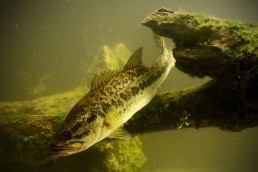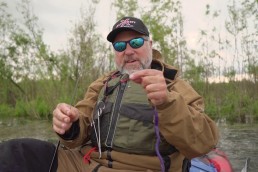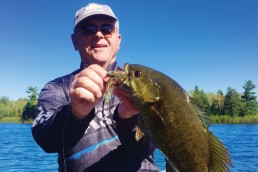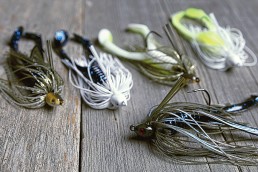Bait Presentation: Cover Contact
SHARE THIS POST
Often the difference between a successful bass outing and a big goose egg can be attributed to small details. It’s usually not so much a particular bait color or brand, the perfect rod and reel combo or line type. Success often happens because of an insignificant nuance to a bait’s retrieve or presentation.
In the last two articles, we discussed how color and vibration affect our approach to successful bass bank angling. Now, let’s look at one more angle in presentation.
This aspect of bait presentation cannot be found by inspecting a bait under bright lights of the tackle shop or by shaking a package to hear a particular sound or vibration. No manufacturers can help you. Instead, this last tweak to your casting for bass fishing success falls upon you, the bass angler.
Contact
Let’s focus on a bass’ response when your bait contacts various types of underwater cover.
If you’re new to bass angling or if this sounds weird, hang in there before you judge this concept’s worthiness.
With the color and sound factors under our belt, this last idea merges with them to ring a bass’s dinner bell!
Baits that contact subsurface structure or cover can move a bass from half-hearted interest and maybe a follow, to slamming your lure as if it were the last bit of forage in the lake.
We’ll cover just a few ideas on bait contact with cover. You can adjust these ideas and add a few more that fit the waters you frequent.
Dredging
This first concept was my very first “cover contact” technique and I’ve used it to catch hundreds of bass from my local waters. I was fishing this technique as a teenager with tackle in the trunk of my ’68 Camaro! Not quite the ideal back road vehicle, but when fishing is your passion, you make things work!
I call it bottom plowing or dredging a deep diving crankbait. Many of the lakes I’ve fished had bottoms of hard clay, which held a favorite bass forage, the crayfish.
I would make long casts, get my deep diver to its maximum depth far from shore, and then bring it back, stirring up the bottom clay with the lure’s deep-diving lip. I’m not talking occasional ticks of the bottom, but flat out digging a trench on the retrieve! In these clear water lakes you could see where I had been fishing by the lines on the bottom. As I walked the bank, the water behind me would cloud up a bit from my bottom plowing. The harder that crank dug, the harder the resident bass hit it. I theorized they responded to the bait as if it were a crayfish stirring up the bottom.
Crashing
While I still plow bottom, I also crash and careen various cranks off underwater objects such as large rocks or wood. To do this, just choose the correct depth bait for your circumstances.
Don’t always think deep water for this technique. I crash shallow cranks off cover in a foot of two of water and catch fish.
Are you enjoying this post?
You can be among the first to get the latest info on where to go, what to use and how to use it!
Select bottom-disturbing crankbaits that float at rest. When you hang up on bottom objects, give a bit of slack line and the buoyancy of a floating crank usually helps it pop free.
Lipless wonders
Lipped crankbaits work best for bottom and cover contact, but lipless designs work better for retrieving baits through areas with sparse weeds or grasses. Diving lips get fouled when running through vegetation, which kills the action altogether. Even snapping the bait usually won’t shake weeds off the bill.
Lipless cranks are better suited to rip through weed cover. We’re talking weeds that are rather sparse, not heavily matted. Most heavily weeded areas need other techniques to draw bass out.
Working lipless baits through weedy areas can be frustrating at first, but with practice you can reap the reward of catching bass most anglers would never consider casting a crankbait to.
The technique is easy. Cast beyond the grass or weeds and start retrieving. When you get into the weeds and feel the lure’s vibration drop off, give your rod a quick snap. This dislodges the weeds from around the line tie and hooks. Keep reeling until you hit the next bit of weeds. Just repeat this retrieve, snapping the bait every time you contact weeds. A full 90 percent of strikes come as the bait snaps free of the weeds. Lots of hits come as your bait snaps free just as the bait exits the cover, too.
Other lures
Don’t limit the cover contact concept to crankbaits. You can work spinnerbaits, chatterbaits, or soft swimbaits with these techniques and make subtle adjustments to your presentation. The more you learn to work your bait beyond its factory-given action, the more fishing success you will experience.
Thumping
I have been experimenting with a concept over the last year with heavy jigs and trailers and Texas-rigged plastics.
This is more of a flippin’ technique without a prompt retrieve. I simply cast to a target area, let the bait settle, then let it stay in place. With small raises of the rod tip, the bait hops up and down in place. Here’s where the heavy weight comes into play. With heavier baits like jigs or fixed weight plastics, 3/4-ounce weights keeps them in place better when you raise the rod tip.
The hops are small, 1 to 4 inches high—not excessive hops such as when snap jigging. I just want to thump that weight on the bottom. It’s that thumping that draws bass in to investigate. You might think that rattling jigs might work better and in certain waters with low visibility I might use them. But usually, I only want the sound of that lead thumping on the bottom. The bass are perfectly capable of hearing it. We often underestimate the bass’s ability to locate forage simply by its sound and vibration.
For this bottom thumping, jigs are my first choice. I have been using heavier 3/4-ounce football head jigs with various plastic bodies, favoring full crayfish bodies or a large creature bait. For heavy plastic presentations without a jighead, I Texas-rig large creature baits or heavy, thick worms. I peg a 3/4-ounce worm weight at the bait’s nose. The pegged weight keeps the bait thumping in place.
So try plowin’, dredgin’, crashin’, rippin’, or thumpin’ this season and increase your success on your favorite bass waters. MWO
If you have any questions or comments you can reach Dan Brozowski at onthebank@att.net.
If you enjoyed this article check out other works of Dan Brozowski
MWO
SHARE THIS POST
Did you enjoy this post?
You can be among the first to get the latest info on where to go, what to use and how to use it!
Dan Brozowski
Passion for angling drives Dan Brozowski to the water’s edge virtually any chance he gets. Although passion cannot be measured, weighed, or recorded, it can be shared. He does this through his writing and while on the water. If you have any questions or comments for Dan, you may contact him at: onthebank@att.net.



